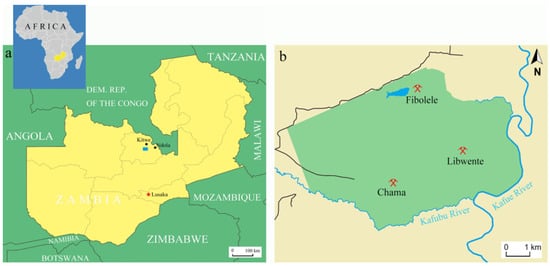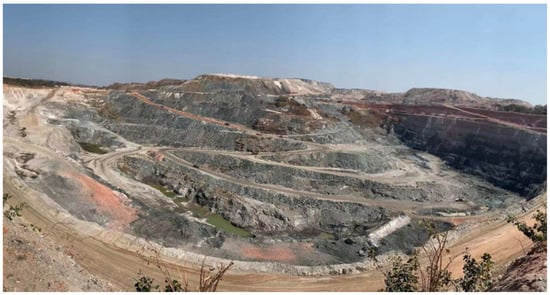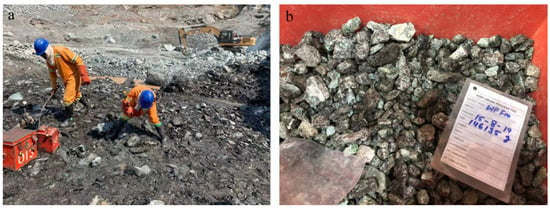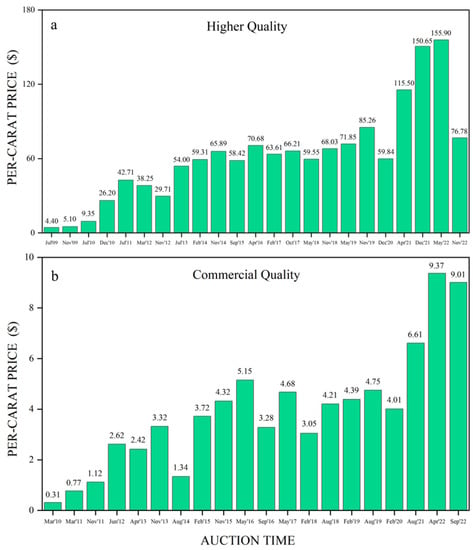You're using an outdated browser. Please upgrade to a modern browser for the best experience.
Please note this is a comparison between Version 1 by Ran Gao and Version 2 by Catherine Yang.
Kagem emerald mine in Zambia is deemed the largest open-pit emerald mine in the world, with extremely high economic value and a large market share. Mineral inclusions typically include actinolite, graphite, magnetite, and dolomite. Black graphite encased in actinolite in Kagem emeralds is reported herein for the first time. The FTIR spectrum of Kagem emeralds reveals that the absorption of type II H2O is stronger than that of type I H2O, indicating the presence of abundant alkali metals, which was confirmed through chemical analysis. Kagem emeralds contain high levels of Na (avg. 16,440 ppm), moderate-to-high Cs (avg. 567 ppm), as well as low-to-moderate K (avg. 185 ppm) and Rb (avg. 14 ppm) concentrations.
- emerald
- Kagem mine
- gemological characteristics
- origin traceability
1. Introduction
Emerald is the green variety of beryl colored by chromium and vanadium, and its ideal chemical formula is Be3Al2SiO18. The traditional classification system for emerald deposits has been expanded upon by Giuliani et al. (2019) [1]. Emerald occurrences and deposits were reclassified into two main types: tectonic magmatic-related (Type I) and tectonic metamorphic-related (Type II), and further subdivided into seven sub-types based on host rock types. The Kafubu deposit in Zambia was classified as Type IA, associated with mafic-ultramafic rocks.
Zambia is one of the most significant emerald sources worldwide, second only to Colombia. Kagem emerald mine is located in the Ndola Rural Emerald Restricted Area and lies south of Kitwe and west of Ndola, in Zambia’s Copperbelt Province (Figure 1). Kagem mine is considered the world’s largest single open-pit emerald mine, accounting for approximately 25%–30% of global emerald production, with a potential mine life of 22 to 2044 years [2]. Besides the Kagem mine, there are other larger mines in the Kafubu area, including Kamakanga, Grizzly, and Chantete [3][4][3,4].

Figure 1. (a) Zambia is a landlocked country located in the southern part of Africa; the capital is Lusaka. The Kagem mine (blue rectangle) is located in north-central Zambia, near the Kafubu River in the Ndola Rural Emerald Restricted Area (NRERA); (b) There are three operating pits in the Kagem mine: Chama, Libwente, and Fibolele. Picture: Ran Gao.
Bank (1974) [5] proposed that the necessary chromic element in emeralds, chromium, comes from the magnetite in talc–magnetite schist. Koivula (1982) [6] was the first to report on the presence of tourmaline in Zambian emeralds. Sliwa and Nguluwe (1984) [7] described the geological setting of Zambian emeralds. Seifert et al. (2004a) [8] first provided quantitative geochemical, petrological, and mineralogical data on the major rock types of the Kafubu emerald deposits. Seifert et al. (2004b) [9] conducted a comprehensive study of the environmental impact of the emerald mines in the Kafubu area. Zwaan et al. (2005) [3] first reported the Musakashi area, a new emerald deposit initially worked by local miners in 2002 [10]. In 2014, GIA Lab conducted a field exploration of the history, region geology, mining methodology, processing, operation, and auction of the Kagem mine, and published a detailed report [11]. However, detailed studies on the spectroscopy and chemical composition of Kagem emeralds still need to be completed [12].
2. Geological Setting
The Kagem emerald concession covers an area of approximately 46 square kilometers within a 200-square-kilometer productive zone, and comprises the current operating Chama open pit mine and the bulk sampling pits at Libwente and Fibolelem [3]. The Kafubu area is located geologically at the center of the transcontinental Pan-African belts in central-southern Africa. The Crustal evolution is thought to be related to three successive orogenic events: the Ubendian, Irumide, and Lufilian (Pan-African) [13][14][15][13,14,15]. The Kafubu emerald deposits occur within metamorphic rocks of the Muva Supergroup that date back to around 1700 Ma [million years ago] [16][17][16,17]. The Muva Supergroup overlays the basement granite gneisses, consisting of footwall mica schist, talc–magnetite schist, amphibolite, and quartz–mica schist from bottom to top. The entire crustal domain subsequently underwent folding, thrusting, and metamorphism during the Pan-African orogeny, peaking at 530 Ma [18]. Emerald mineralization in the Kagem mine is hosted by the talc–magnetite schist, which contains talc–chlorite–actinolite–magnetite schists (Figure 2) [7][14][7,14]. These schists were identified as metamorphosed komatiites—Mg-rich ultramafic rocks [9]. During the late stages of the Pan-African orogeny, the talc–magnetite schist was intruded by beryllium-rich pegmatite dykes (typically 2–10 m thick) [19][20][19,20]. These pegmatites appear as feldspar–quartz–muscovite bodies or as minor quartz–tourmaline veins, and are believed to be related to neighboring granitic rocks [7]. The steeply inclined pegmatite dykes and quartz tourmaline veins typically trend north to south or northwest to southeast. The emerald mineralization in the Kagem mine results from the interaction between metabasites and pegmatites and their accompanying hydrothermal fluids [9][19][9,19]. Emeralds are found in the phlogopite reaction zone (typically 0.5–3 m wide) between the talc–magnetite schist and the pegmatites, and in the quartz–tourmaline veins, which produces gem-quantity emeralds, but only a tiny percentage [3]. In the reaction zone, talc–magnetite schist provides the important chromophore of chromium, while the pegmatites provided the beryllium. Emeralds were formed under the proper pressure, temperature conditions (400–600 MPa and 590–630 °C), and chemical environment, around 500 Ma [9][21][9,21]. The area subsequently underwent intense shearing and folding during the Lufilian orogeny, which may account for the fracturing and opacity of many emerald crystals [7].
Figure 2. Schematic representation of the metasomatic reaction zone between the talc–magnetite schists, and the pegmatite-formed common beryl and gem-quality emeralds. Modified from [22].
3. History
There are two major emerald areas in Zambia: the Musakashi and Kafubu areas. The Musakashi area was first reported in 2005. The emeralds from this area were characterized by their intense bluish-green color and multiphase inclusions, which were similar to the emeralds found in Muzo, Colombia [3][10][23][3,10,23]. Beryl was first discovered in the Kafubu area in 1928 by two geologists named Dicks and Baker. Some small exploration works were carried out during the 1940s and 50s [7]. Zambia’s Geological Survey Department mapped the Miku area and verified the deposit in 1971 [13][14][13,14]. After new occurrences were discovered in the 1970s, the Kafubu area became a significant producer of high-quality emeralds. Because of the dramatic expansion of production and extensive illegal mining, the Government relocated the local population and established a restricted zone called the Ndola Rural Emerald Restricted Area [9]. In 1980, Kagem Mining Ltd. (55% owned by the Zambian Government) was authorized to explore and mine the Kafubu area in the same year [9]. In 2004, the British public-listed Gemfields Resources PLC began systematic exploration near the Pirala mine, south of the Ndola River, and discovered significant emerald deposits. Gemfields was awarded a management contract there in 2007. In the following year, Gemfields acquired 75% ownership of the mine, the remainder being held by the Government [11]. Kagem is primarily an open-pit mine, which presents the advantage of providing accessibility to every carat of emerald (Figure 3). After the surrounding rock is removed, miners utilize hammers and chisels to recover the emeralds. Any extracted production goes into a red production box (Figure 4). Since 2010, the Kagem mine has been responsible for approximately 50% of emerald production in Zambia. Despite the high production volume, only a small portion of gem-quality emeralds are available for exportation. In 2022, the Kagem mine produced a total of 37.2 million carats of emeralds and beryl, including 259,500 carats of premium emeralds [24].
Figure 3.
The Kagem mine is the world’s largest open-pit mine for emeralds and is located in the Ndola Rural District, Copperbelt Province, Zambia. Photo by Xiangjie Xiao.

Figure 4.
(
a
) Miners use hammers and chisels to extract emeralds from the rock in the reaction zone; (
b
) The collected emeralds in a secure box. Photo by Xiangjie Xiao.

Figure 5. (a) The per carat price (calculated as: received/total weight sold) for higher quality emeralds from the Kagem mine at auctions, tracked since July 2009; (b) The per carat price for commercial quality emeralds from the Kagem mine at auctions, recorded since March 2010. Auction data from [24].
